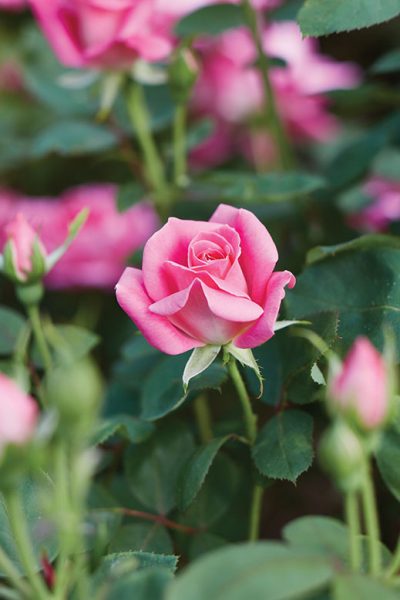
WEATHER REPORT
New Jersey is divided into four zones to insure that plants survive the weather, especially the first and last freezes each year. “Zone information should always be considered for plant health,” says master gardener Pat Scarano. While the general rule for spring planting is May 15, Scarano suggests checking frost dates for your town. The website planthardiness.ars.usda.gov has zone information. “In Old Bridge, where I live,” Scarano says, “the first and last freeze dates are October 20 and April 20.” Adds Alexandra Rakoczy, a landscaper with the Farm at Green Village, “Plants typically have their hardiness zones listed on their tags…or if annuals, the length of their growing season.”
HERE’S THE DIRT
Soil also differs among regions. “The most common problems we run into are soils with either too much clay or soils that are too sandy,” says landscape architect Celia DeHuff, owner of Hedges Landscape Design in Morristown. “Too much clay slows down the water flow and root growth,” adds DeHuff, “while sandy soils allow the water to flow through too quickly, making it unable to hold nutrients.”
DeHuff recommends amending soil with Biochar, or ground charcoal. “Biochar has the ability to increase water retention in sandy soils and is able to decrease it in clay soils,” she explains. “It also increases nutrient retention.” Composting and mulching are essential for nutrient-rich soil—“but be sure to use a natural mulch, not the dyed kind,” says LeeAnn Lavin, owner of Duchess Designs in Atlantic Highlands. If you’re unsure of the composition of your soil, have it tested, suggests Scarano. The Rutgers Soil Testing Laboratory (732-932-9295) will analyze your soil for a fee.
WHAT TO PLANT
Our experts agree that native plants fare best. Lavin suggests plants such as milkweed, bayberry and orchids, for starters. There are dozens more. Rakoczy’s list includes winterberry, dogwood, red maple, and some ornamental grasses. For a more thorough list, consult the Native Plant Society of New Jersey. “Natives are not only strong, resilient and easy care, but they provide food for local and traveling pollinators,” says Lavin. “Our area is the route for so many butterflies, hummingbirds and bees. If you plant a variety of natives, you’ll be rewarded with these beautiful creatures flitting about.”
SUN OR SHADE?
Yes, you can grow beautiful flowers in the shade. “Hydrangeas, peonies and rhododendron are all shade tolerant,” says master gardener Caroline Yourcheck. “I have some pockets of deep shade in my garden and have successfully, and surprisingly, grown some flowering perennials, like variegated Solomon’s seal, hellebore, trillium and anemone canadensis.” Conversely, she says, daylilies are perfect in full sun.
BEYOND GRASS
Alternative ground covers can fill areas where grass won’t grow, says Sean Smith of the Farm at Green Village. “As a lawn, white clover is a great option,” he says. “It’s still nice and green, stays low to the ground so it rarely if ever needs to be cut, and it flowers white, which is pretty, and bees love it.” It also requires less fertilizer and pesticide than traditional lawns. Other options include certain varieties of moss, thyme, chamomile and low-growing sedum. DeHuff suggests native foamflower, an ideal ground cover for moist, shady areas. Lavin, for one, pleads for fewer lawns. “Home lawns take too much water and rob the soil of needed nutrients,” says Lavin. “While there’s no doubt a verdant, green expanse is lovely, leave the big lawns to the golf course, football fields or parks.”

Milkweed is a highly invasive weed, we pulled a ton of it out of our front yard landscape where it choked out 2 Winter Glory bushes that my parents planted here more than 50 years ago–a heartbreak–plus it is not an attractive plant and has berries that the birds feast on and then splat on your cars , etc.